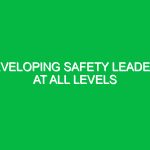In today’s complex and ever-evolving work environments, the concept of Safety Leadership emerges as a critical factor in ensuring the health and safety of employees. Safety leadership goes beyond merely enforcing rules; it encompasses a proactive approach to fostering a culture of safety that permeates every level of an organization. It is about instilling values, behaviors, and practices that prioritize the well-being of every worker. This article delves into the essence of safety leadership, its relevance within the health, safety, and environment (HSE) domain, and the multifaceted risks associated with it. Furthermore, we will explore effective safety precautions, best practices, and the regulatory framework that guides these efforts.
Understanding Safety Leadership
At its core, safety leadership is the ability of individuals, particularly those in managerial or supervisory positions, to influence others to prioritize safety in their daily operations. It involves setting clear expectations, providing the necessary resources, and leading by example. A safety leader is someone who not only understands safety protocols but also communicates their importance effectively. They inspire their teams to engage actively in safety practices, making it a shared responsibility rather than a top-down mandate.
The relevance of safety leadership in the HSE domain cannot be overstated. According to the National Safety Council, workplace injuries and fatalities have significant financial implications, not to mention the human costs involved. A strong safety leader can significantly reduce these incidents by fostering a culture where safety is ingrained in the organizational fabric. By understanding the dynamics of team behavior and organizational culture, safety leaders can shape a proactive approach to risk management.
Identifying Hazards and Risks in Safety Leadership
Every workplace has its unique set of hazards and risks, which can be broadly categorized into physical, chemical, biological, ergonomic, and psychosocial hazards. Understanding these risks is the first step in effective safety leadership.
Physical Hazards
Physical hazards include any environmental factors that can cause harm. This could range from machinery operation to slips and falls. For instance, in a manufacturing facility, inadequate machine guarding can lead to severe injuries. Safety leaders must conduct regular audits and ensure proper training for machine operators to mitigate these risks.
Chemical Hazards
Chemical hazards involve exposure to harmful substances, whether through direct contact or inhalation. Consider a scenario in a chemical plant where improper storage of hazardous materials leads to spills. A safety leader must implement robust safety data sheets (SDS) and training programs that emphasize the correct handling and storage of chemicals.
Biological Hazards
Biological hazards can arise from exposure to viruses, bacteria, or other pathogens. In healthcare settings, safety leaders must ensure that protocols are in place for infection control. This includes proper sanitization practices and the use of personal protective equipment (PPE) to safeguard healthcare workers.
Ergonomic Hazards
Ergonomic hazards result from poor workplace design, leading to musculoskeletal injuries. A safety leader should advocate for ergonomic assessments and adjustments, such as adjustable workstations, to enhance worker comfort and reduce injury risks.
Psychosocial Hazards
Psychosocial hazards relate to stress, bullying, or harassment within the workplace. These can significantly affect employee mental health and overall productivity. Safety leaders must foster an open environment where employees feel comfortable reporting issues without fear of retaliation.
Best Practices and Precautions in Safety Leadership
Implementing effective safety leadership practices is crucial to mitigating the risks outlined above. Here are some actionable strategies that safety leaders can adopt:
1. Cultivating a Safety Culture
Establishing a safety culture requires consistent messaging and reinforcement from leadership. Safety leaders should prioritize open communication, encouraging employees to express their safety concerns. Regular safety meetings and discussions can help maintain this focus.
2. Providing Comprehensive Training
Training is the backbone of effective safety leadership. Employees must be equipped with the knowledge and skills to recognize hazards and respond appropriately. Safety leaders should ensure that training is not just a one-time event but an ongoing process that evolves with the organization’s needs.
3. Leading by Example
Actions speak louder than words. A safety leader should model safe behaviors consistently, demonstrating a commitment to safety. For instance, wearing appropriate PPE and adhering to safety protocols sends a powerful message to the team.
4. Utilizing Data and Technology
Data-driven decision-making can significantly enhance safety practices. Safety leaders should leverage technology, such as incident reporting software or safety management systems, to track safety performance metrics. This data can help identify trends and areas for improvement.
5. Creating a Reporting System
A robust reporting system encourages employees to report near-misses and unsafe conditions without fear of repercussions. This proactive approach can help identify potential hazards before they result in accidents.
Regulations and Standards Governing Safety Leadership
Safety leadership is also guided by various regulations and standards that aim to protect worker health and safety. Familiarity with these frameworks is vital for effective safety management.
Occupational Safety and Health Administration (OSHA)
In the United States, OSHA sets and enforces standards to ensure safe working conditions. Compliance with OSHA regulations is a fundamental responsibility of safety leaders. They must ensure that their organizations adhere to these standards to avoid penalties and, more importantly, to protect their employees.
ISO 45001
ISO 45001 is an international standard for occupational health and safety management systems. It provides a framework for organizations to improve employee safety, reduce workplace risks, and create better working conditions. Safety leaders should consider obtaining ISO certification as it demonstrates a commitment to safety excellence.
National Fire Protection Association (NFPA)
The NFPA provides guidelines for fire safety, which are crucial in many industries. Safety leaders should ensure that their organizations comply with NFPA standards to minimize fire-related risks and ensure employee safety.
Real-Life Example: Safety Leadership in Action
One compelling example of effective safety leadership in action comes from the oil and gas industry. After a significant incident at a major refinery, the company implemented a comprehensive safety leadership program. This initiative included extensive training for all employees, focusing on hazard recognition and response. The program also emphasized the importance of reporting near-misses. Over a two-year period, the company saw a remarkable reduction in incidents, with a 40% decrease in injuries. This transformation highlights how strong safety leadership can lead to tangible improvements in workplace safety.
Conclusion
In conclusion, Safety Leadership is an indispensable element of effective health, safety, and environmental management. By understanding the various hazards and risks, implementing best practices, and adhering to relevant regulations, safety leaders can create a safer workplace for everyone. The journey toward safety excellence is ongoing and requires commitment, communication, and a willingness to adapt. As we move forward, fostering a culture of safety will not only protect employees but also enhance organizational resilience and productivity.


